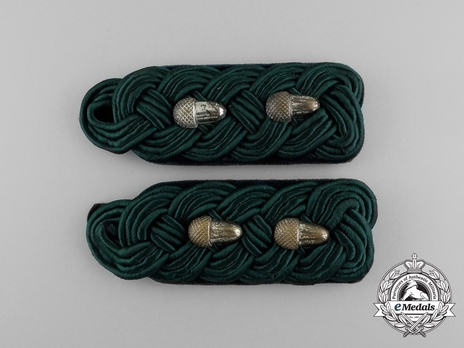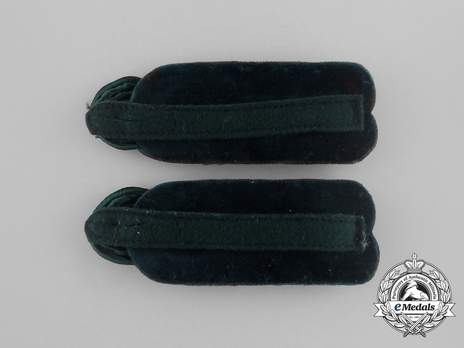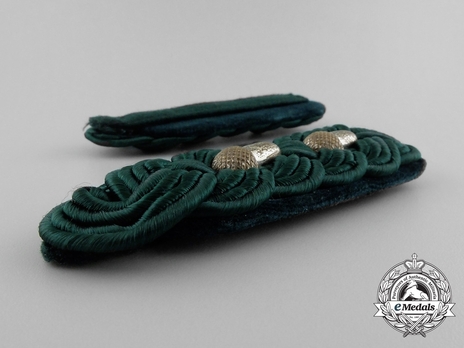Forestry 1942 Pattern Oberförster Shoulder Boards
CATEGORY: Version
SKU: 75.GOR.03.02.01.04.012.000
Estimated market value:



Estimated market value:
The boards are constructed of a cardstock core with a forest-green silk backer. The obverse of the shoulder boards are ordained with four rows of matching forest green interwoven braids in a chevron formation, with a loop on the outer edge creating a button hole for uniform attachment. Each board also features two gilded acorns, both with all prongs fully intact and showing on the reverse. The reverse of each features a wool strap with a button hole for uniform attachment; measuring 99 mm x 36 mm; near extremely fine condition.
Like every organisation during the Third Reich, forestry was placed under the control of the NSDAP. The Reichsforstamt (National Forestry Office) was created in 1934 to replace the regional forestry departments that had existed prior to this date. The goals of the Reichsforstamt were to extract economic value in the form of timber from the forests for the German industry, as well as preserve nature and natural monuments for the people as a part of German culture.
A sub-department for professional hunters employed by the government was created. Hunting matters had formerly been a part of the Ministry for Food and Agriculture, but were now placed under the influence of the Reichsforstamt.
Private forestry matters were placed under the care of the Reichsnährstand (National Nutritional Estate) in 1941.
The Reichsforstamt was headed by Luftwaffe leader Hermann Göring as Reichsforstmeister (minister of forestry).
The Reichsbund Deutsche Jägerschaft (National Society of German Hunters) was founded in 1934 as a statutory corporation for non-professional hunters. All existing hunting societies were disbanded and memberships transferred to the Deutsche Jägerschaft. Membership was mandatory for everyone with a hunting license.
Hermann Göring led the organisation as Reichsjägermeister (minister of hunting).
The Reichsforstschutz or Forstschutzkommando (Forestry Protection Service), in 1943 renamed to Forstschutzkorps (Forestry Protection Corps), was a paramilitary force instituted in February of 1940 in the General Government (occupied Poland). Made up of German forestry officials and ethnic Germans from Poland, the Forstschutz was tasked with regular forestry duties, as well as patrolling and protecting woodlands to keep them from being used by the Polish resistance. In 1942, Forstschutz personnel was also stationed in the Eastern European occupied territories where their work was heavily focused on anti-partisan operations.
Very little is known about the Forstschutz organisation today, and all items related to it are exceedingly rare.
The fourth pattern of Forestry shoulder boards was introduced in 1941, but due to difficulties with distribution, wasn’t implemented until November of 1942. The colour of the cords was changed back to regular green, compared to the third pattern’s aluminum green colour. As well, the metal acorn rank pips saw a return and replaced the four-sided star rank pips. They were silver-coloured for all ranks except for the highest ranks, which used gold-coloured acorns.
The shoulder boards are as follows:
The Reichsforstmeister wore gold/silver/gold triple-cords braided to form four bends and a button loop, with two crossed silver-coloured oak leaves.
Generalforstmeister wore two green double-cords braided to form four bends and a button loop, on a secondary gold-coloured underlay, with three gold-coloured acorns.
Ministerialdirektoren wore the same shoulder boards as the rank above, but with only two gold-coloured acorns.
Ministerialdirigenten wore the same shoulder boards as the rank above, but with only one gold-coloured acorn.
Oberlandforstmeister wore the same shoulder boards as the rank above, but without any acorns.
Landforstmeister wore two green double-cords braided to form five bends and a button loop, on a secondary silver-coloured underlay, with three silver-coloured acorns.
Oberforstmeister wore the same shoulder boards as the rank above, but with only two silver-coloured acorns.
Forstmeister wore the same shoulder boards as the rank above, but with only one silver-coloured acorn.
Forstassessoren wore the same shoulder boards as the rank above, but without any acorns.
Forstreferendare wore five green double-laid parallel cords with a secondary silver-coloured underlay.
Forstamtmänner wore two green double-cords braided to form five bends and a button loop, with three silver-coloured acorns.
Oberförster wore the same shoulder boards as the rank above, but with only two silver-coloured acorns.
Revierförster wore the same shoulder boards as the rank above, but with only one silver-coloured acorn.
Supernumerary Revierförster wore the same shoulder boards as the rank above, but without any acorns.
Revierförsteranwärter wore five green double-laid parallel cords.
Oberforstwarte wore four green double-laid parallel cords with two silver-coloured acorns.
Forstwarte wore the same shoulder boards as the rank above, but with only one silver-coloured acorn.
Supernumerary Forstwarte wore the same shoulder boards as the rank above, but without any acorns.
Forstwartanwärter wore three green double-laid parallel cords.
Forstaufseher wore two green double-laid parallel cords.

Comments
Sign in to comment and reply.


Scroll Top